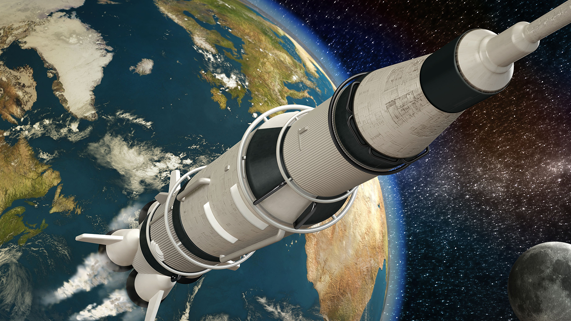
In a marketplace far, far away
July 15, 2021 | By Ina WancaOn July 20, 1969, Neil Armstrong set foot on the moon. This “giant leap for mankind” represented one of the greatest engineering achievements of all time, and turned the dream of space travel into a reality. Fifty years later, we are again at the edge of that reality with companies including Blue Origin, SpaceX and, just this week, Virgin Galactic leading the way to the stars.
In 2020, space investment was up to $12.1 billion, with space tourism projected to be a $3 billion market by 2030. While still in a nascent stage, space tourism can open up new possibilities for consumer travel experiences — and how to pay for them while we’re off-planet. What’s the currency conversion fee in the cosmos? Can we tap and go extraterrestrially? Is interoperability possible at an interplanetary level?
Day trips to the stars may be years away, but the practical work on space payments is already underway. For example, five years ago, First Data and Nationwide Building Society completed the first contactless transaction at 100,000 feet above Earth's surface using a weather balloon and robotic arm. As consumers will likely expect the same seamless experiences in space as on Earth, what are some considerations to make space payments a reality?
Connectivity
There are nearly 5,000 satellites revolving around the Earth’s orbit, according to the United Nations Office for Outer Space Affairs. GPS, mobile phone networks and IoT devices depend on satellites for their system communications and operations. Today, private companies are harnessing technology to launch satellites that are smaller, more accessible and more affordable than the ones previously developed for military and scientific purposes. Companies are now working toward providing high-quality and fast broadband networks using these satellite systems. By developing a subscription-based model, businesses and space travelers will have the infrastructure to conduct payments in outer space.
Keeping time
The ability to keep synchronized time in space is important, especially in coordinating with Earth’s financial markets. The need to have the most accurate time-telling devices that provide true synchronization has led to the development of the Deep Space Atomic Clock (DSAC), a small, ultra-precise mercury-ion timekeeper to replace the current refrigerator-sized atomic clocks that are too bulky to be sent into space. The DSAC was launched in June 2019, and in addition to opening up untold opportunities in the world of atomic timekeeping for space travel, it will no doubt greatly impact consumer and business trade in the next frontier.
Tracking payments
On Earth, authorizing transactions, including fraud checks by multiple parties, occurs in the blink of an eye. But communication between Earth and Mars, say, could take anywhere from 4 to 24 minutes — one-way. A payment could take as long as 45 minutes to conclude. That’s a long time for an interstellar latte. That’s why blockchain technology, which creates irrefutable records, has been floated as an ideal solution for transacting business in outer space. The tracking of money and inventory extends beyond payment. Blockchains provide transaction ledgers that can accommodate not just payments, but also supplies and their inventory, use and movement. As transaction ledgers are adapted to meet the complex needs of outer space, perhaps with the creation of an interplanetary file system, the improvements to the use of blockchain systems will no doubt increase the effectiveness and power with which we use blockchain to manage our finances here on Earth.
Cybercrime protection
The development of machine learning and artificial neural networks is having a significant impact on space exploration, with applications ranging from navigation and enhanced situation self-awareness to spacecraft system design. Artificial intelligence in space could also help prevent cybercrime — in fact, the first alleged crime committed in space was a financial one, with an astronaut accused of hacking her estranged spouse’s bank account from the International Space Station — as well as providing insights and support to consumers in space. Space satellites, just like any other digitalized critical infrastructure, are vulnerable to cyberattacks by jamming, spoofing or hacking. Additionally, the huge amount of data disseminated through satellites makes it possible for criminals to corrupt the accuracy and reliability of data. In this context, designing and launching quantum AI-based satellites could potentially provide security and solve the risk of satellite data transmission.
We are marching toward the next space initiatives — NASA launched the Mars 2020 Perseverance rover last year to further explore the Martian surface and test technology to address future human missions there. Banks and other parts of the payment ecosystem can leverage AI technologies to adapt to the emerging reality, which involves exploring bigger questions such as: How will risk and fraud management evolve? How will customer support develop? What would our standard currency will look like in a cash-free interplanetary society?
Since the lunar landing, space has become the new frontier of innovation. Space technologies have revolutionized terrestrial industries including aviation, health and food. With the growth of space tourism, earthbound technologies will inevitably evolve for space — and galactic payments may be next to launch.
This story was first published July 30, 2020. It was updated to include news on Virgin Galactic's first fully-crewed space flight.
